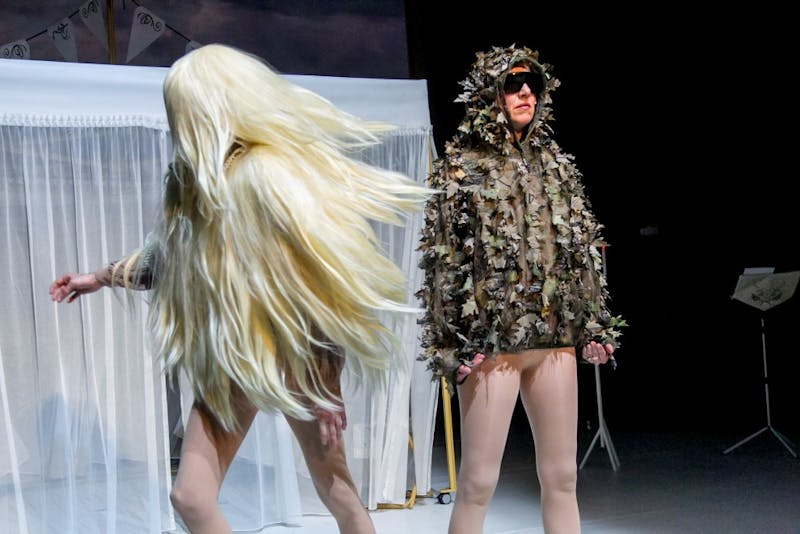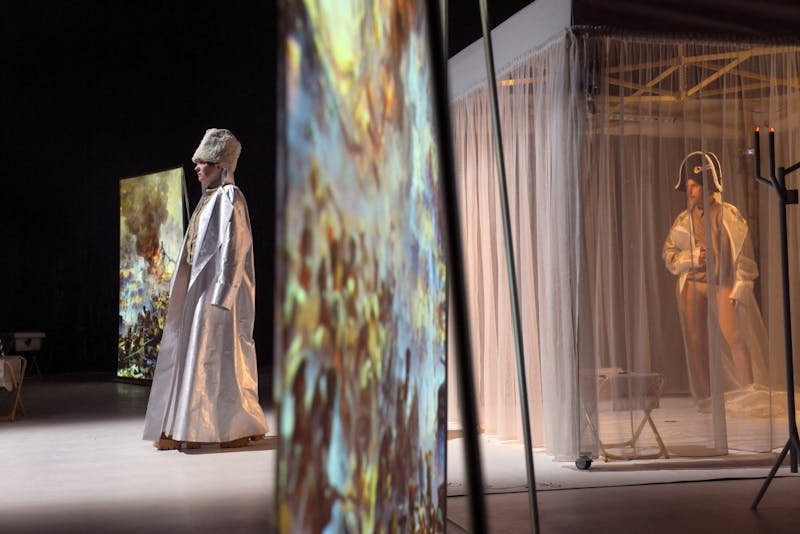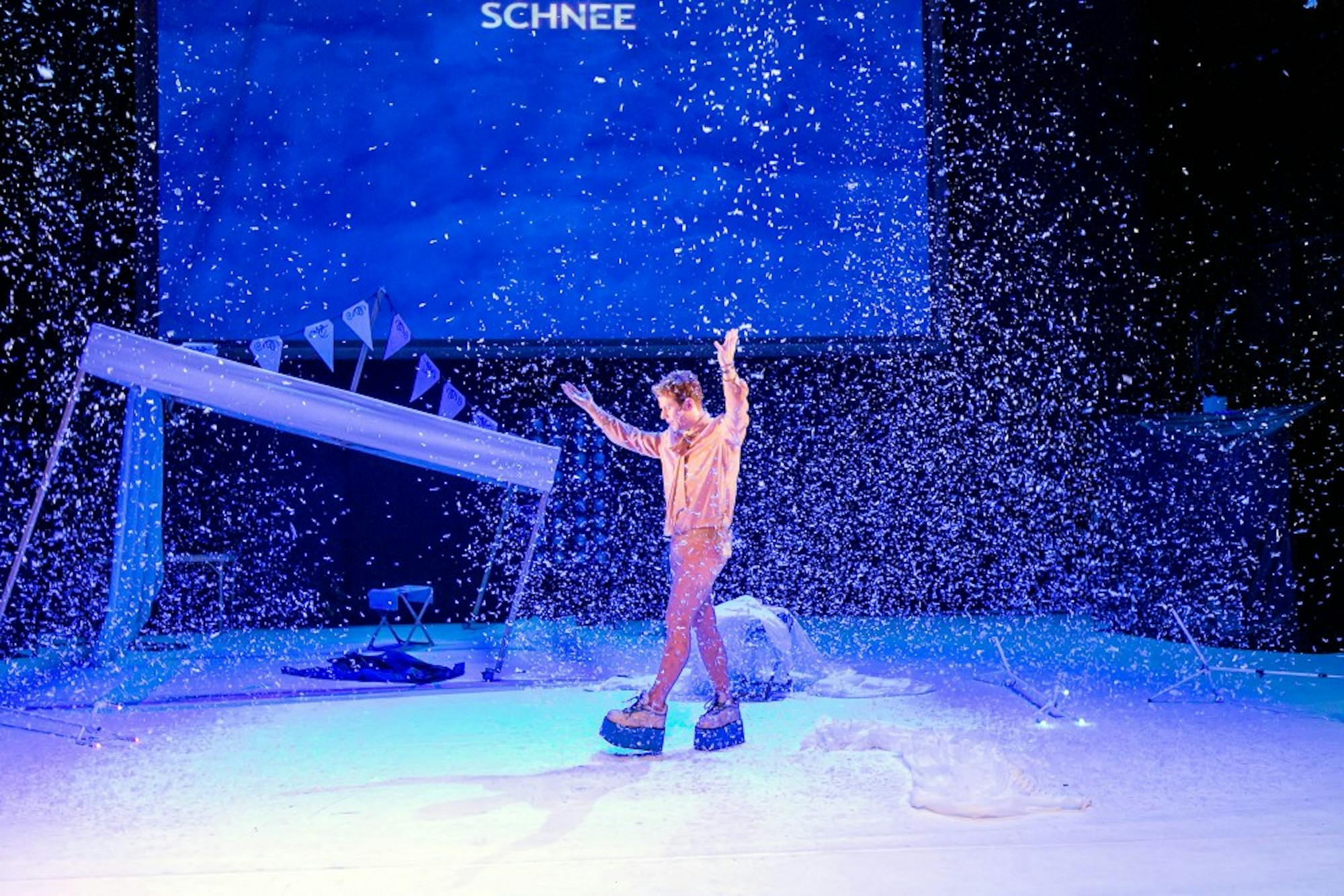What do a reunited One Direction, a historical fashion show and Leo Tolstoy kissing Vladimir Lenin have in common? They were all a part of Gob Squad’s performance of “War and Peace” this past weekend at the Moore Theater.
Gob Squad is an arts collective comprised of seven British and German artists. Together, they create performances that ponder major philosophical questions by using humor and audience participation. “War and Peace,” their latest project, seeks to discuss a major question people may have after reading Tolstoy’s novel about Napoleon’s invasion of Russia in 1812: Why do people go to war, and should they?
Before the show even began, it was clear that this rendition of “War and Peace” would not take itself as seriously as the epic novel does. Upon walking into the Hopkins Center for the Arts to attend the performance on Friday night, I was immediately greeted by four members of Gob Squad in costume: nude tights, flowy shirts and long sheaths. One member wore platform shoes that made him about six inches taller.
Once audience members began flooding the theater, members of Gob Squad simulated the atmosphere of a French salon by bringing show-goers onto the stage and introducing them. Every now and then, an audience member would be invited to “sit at the table.” The literal table was set up at the front of the theater, complete with bottles of wine, small baked goods and a rotatable camera four Gob Squad members used to project their live conversations with those selected from the crowd.
Gob Squad’s rendition of “War and Peace” did not assign roles to each performer like in a traditional play. Instead, performers were assigned a “pathway,” a more relaxed version of a role that allows for more creative freedom and improvisation. Each member of the squad embodied one of four “pathways”: Tolstoy, War, Peace or “And.” Sharon Smith, who played Tolstoy, was at once a fantastically funny host and a prolific philosopher. At the table, she discussed the current political divide in America with her guest. This rather serious discussion was often cut by camera shots of Gob Squad member Simon Will, who portrayed the pathway “And,” miming playing a harp to “Imagine” by John Lennon and scarfing down any remaining pastries at the table.
After establishing the guests of the table, Gob Squad launched into a fashion show comprised of characters from the novel, staples of war and important political figures. The participants ranged from protagonist of “War and Peace” Pierre Bezukhov to a war horse to Parkland survivor Emma González.
Tatiana Saphir, who portrayed the pathway War and the character Napoleon, then entered into a battle of wits and humor with Sarah Thom, who portrayed Peace and impersonated Tsar Alexander I. This battle eventually morphed into Will singing Coldplay’s “Viva la Vida” and Thom acquiring a Tolstoy-like beard.
Despite the fact that this rendition of “War and Peace” incorporated “pathways,” much of its material was comprised of the personal experiences of the performers. One of the more compelling moments of “War and Peace” was when Thom discussed the death that accompanies war in relation to her father’s recent passing. Another emotionally charged moment came towards the end when Smith, a mother and wife, wondered aloud how she would be able to explain violence to her young child.

The very last moment of “War and Peace” was based on a quote from the novel discussing an aging oak tree. As Will mused about what that oak tree would have to say about all the life and violence it had seen, his cast mates took the stage dressed as trees with their table guests. As they stared off at a projected overcast sky, the lights faded out.
So, what exactly was Gob Squad’s “War and Peace” all about? Ever since leaving the theater, I’ve found it difficult to answer this question. At the surface, it seems easy to explain “War and Peace” as a humorous conversation about Tolstoy’s novel. Certainly, Gob Squad discusses enough of the plot of the novel for someone who has not read the book to understand its premise and historical background. They offer one possible explanation for why the book remains so beloved: readers of “War and Peace” can sympathize with the novel’s protagonist regardless of the times. By having three people portray Pierre Bezukhov from the novel, Gob Squad highlights the particular characteristics that make him relatable.
Another possible answer is that Gob Squad wanted to show how scarily relevant “War and Peace” is today. During the performance, Gob Squad discussed political disagreements with the people at the table. In one part of the piece, they warn the audience that they will be showing “images of war” on large screens before — thankfully — showing a montage of kittens and dogs playing with their owners. By bringing the 19th century novel into modern times, Gob Squad shows that war and violence is often caused by people’s inability to reach across political lines and find common ground.

I would describe “War and Peace” as a treatise on the morality of war and human nature. A moment that stood out to me was Smith and Will’s conversation about why people might go to war. Smith’s answer had to do with an individual’s inner responsibility to fight fascism and not to become complacent in systems he or she finds morally inexcusable. It is difficult to describe the reasons behind violence — whether in Tolstoy’s novel or in the world today — but Gob Squad did a pretty decent job in their two-hour-long show.
After the final bows, I heard show-goers around me asking their friends and family what Gob Squad was trying to say. I do not think they were trying to say anything. Rather, I think they were trying to leave us with questions — questions about ourselves, the world we live in and our responsibility as people living in that world.




